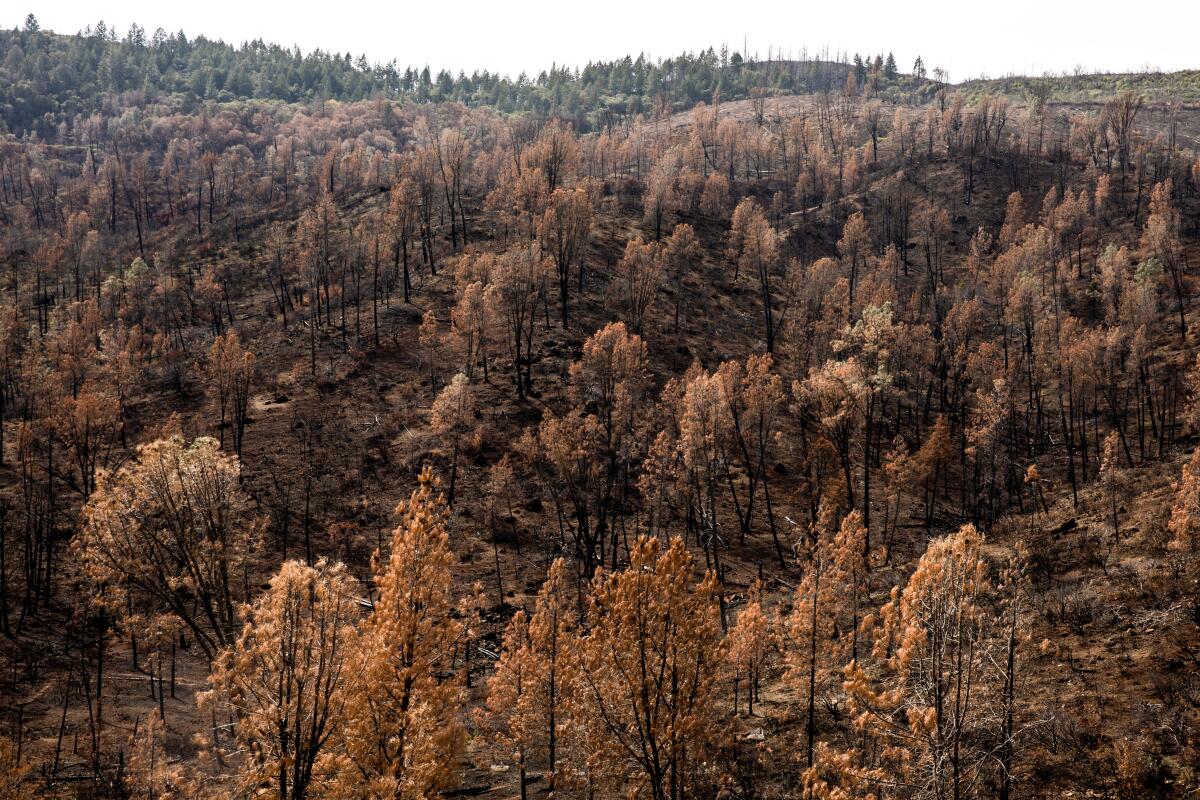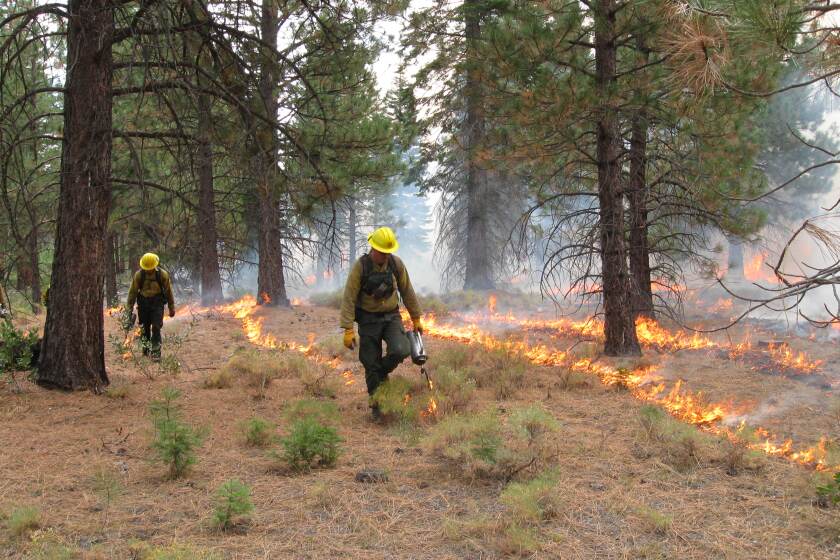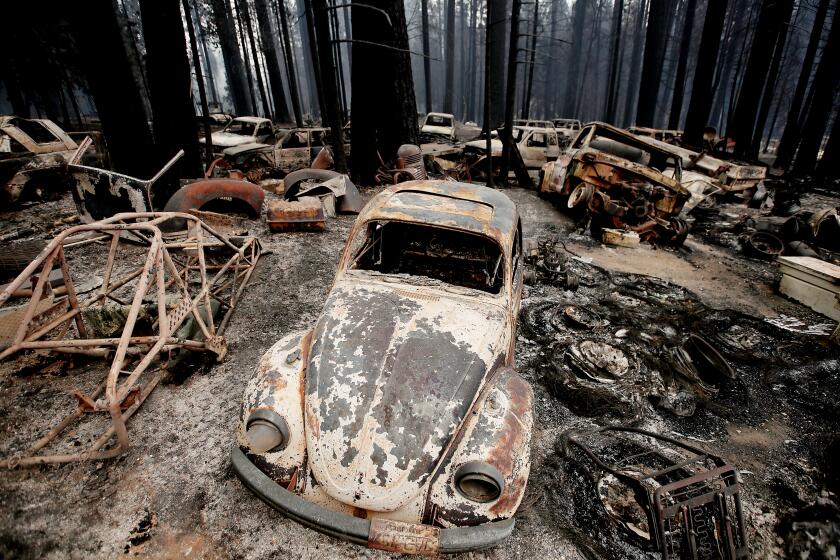Judge pauses California luxury development over wildfire evacuation concerns

When Lake County approved plans for a sprawling, luxury development in the Guenoc Valley wine region in the summer of 2020, officials hailed the project as an economic “game-changer” that would create “mind-boggling” employment.
But almost a month later, as the lightning-sparked LNU Lightning Complex fire enveloped the development’s only evacuation route — a two-lane highway that winds through a steep canyon — critics said the plan was a potential disaster not only for future residents, but for those who already lived nearby.
Had the project been completed, they said, thousands of evacuees could have spilled onto the road and created a bottleneck similar to the one that doomed residents of Paradise in the 2018 Camp fire.
Now, a state court has sided with environmentalists and the California attorney general, and ruled that the county must set aside its approvals of the 16,000-acre mixed-use project, dubbed Maha Guenoc Valley, because the county failed to properly analyze how the development would affect evacuation routes during a wildfire.
It’s unclear what the ruling means for the future of the project, but the decision is just the latest in a number of cases that are focusing on the hazards posed by large developments in areas of growing wildfire risk.
The development, which calls for a mix of boutique hotels, residences and workforce co‐housing units along with retail and recreational amenities, would bring an estimated 4,070 new residents to the area — significant given the census tracts where it is had an estimated population of 10,163 in 2017. “The additional people competing for the same limited routes can cause congestion and delay in evacuation, resulting in increased wildfire related deaths,” Lake County Superior Court Judge J. David Markham wrote in his ruling issued last week.
The project site, like much of Lake County, has seen its share of wildfires. In addition to the 2020 blaze, the development’s footprint has been scorched by wildfire in 1952, 1953, 1963, 1976, 1980, 1996, 2006, 2014, 2015 and 2018, according to the attorney general’s office, which joined a lawsuit challenging the project.
“It’s not a question of if this area needs to be evacuated, it’s a question of when,” said Peter Broderick, attorney for the nonprofit Center for Biological Diversity, which filed the suit.
“We are reviewing the Lake County Superior Court’s ruling,” Chris Meredith, a partner in the project being developed by Lotusland Investment Group, said in a statement. “We remain committed to working alongside the Lake County community and fire safety experts to ensure this project is built in the right way to improve wildfire detection, prevention and response throughout the region.”
Lake County representatives said the path forward would depend on what can be accomplished from a regulatory standpoint and what steps the development team is prepared to take.
“If the ultimate result of this decision is the project not moving forward, that will be a tremendous loss,” said a statement from county Supervisor Moke Simon, who represents the district where the project is and had praised it for providing sorely needed economic benefits and new housing units to the rural county that ranks among the state’s poorest. “We will continue to welcome any future opportunities to partner with Lotusland and others to promote thoughtful development in Lake County.”
The decision comes months after judges, citing fire risk, struck down approvals of a 1,119-home development in a fire-prone area of San Diego County and of a 19,300-home community on the southern flanks of the Tehachapi Mountains in Los Angeles County. The developers of the latter project later reached an agreement with environmentalists to dedicate funding for fire protection and prevention and to build zero-emission homes.
The orders reflect a growing realization that developers simply can’t continue to push into unoccupied areas without dramatically increasing fire risk, especially as climate change-fueled warming and drying has primed more land to burn more intensely, said Stephanie Pincetl, a professor at UCLA’s Institute of the Environment and Sustainability.
“I think it’s showing that people are beginning to understand the land use patterns of the past are not ones we can continue to practice,” said Pincetl, who studies climate change, sustainable cities and wildfires. Humans start roughly 95% of the state’s wildfires, so when they move into a previously undeveloped area, the risk of ignition skyrockets along with the risk to life and property, she said.
Even as evidence mounts that prescribed burns are effective in reducing wildfire risk, the U.S. Forest Service and other agencies are falling behind.
State Atty. Gen. Rob Bonta said that local governments and developers have a responsibility to take a hard look at such projects. “We can’t keep making shortsighted land use decisions that will have impacts decades down the line,” he said in a statement.
Lotusland Investment acquired the property in 2016 and said its development would make Lake County a destination resort area. Formerly the retreat of British actress Lillie Langtry, the ranch is filled with oak woodlands, grasslands, vineyards and grazing pastures. It was among the largest contiguous private properties in California, the group said at the time.
In addition to 1,400 residences and up to 850 hotel rooms and resort apartments, plans called for an equestrian center, golf course, stores and restaurants. The developer estimated the project would employ more than 500 people full time during 10 years of construction and more than 300 full-time hospitality, maintenance and administrative employees upon completion of its first phase.
Lotusland also submitted a 39–page wildfire prevention plan that it said was created in collaboration with the county and the California Department of Forestry and Fire Protection. The plan called for a series of fire breaks, herds of goats, sheep and cattle to graze dry grasses and an emergency response system featuring high-definition fire detection cameras, an onsite fire station and a helipad.
County Supervisor Simon lauded the proposed development as an example of one that would prevent fires rather than create them.
“In recent years, state policymakers have tried to limit development in rural communities, in response to wildfire concerns,” he said in a statement in March. “My position has long been that we need to build smarter in rural California, rather than stopping development, altogether.”
He said that wildfires had destroyed 5.5% of the county’s housing supply since 2015, exacerbating long-standing economic challenges. Developing more housing and attracting more businesses was necessary to strengthen the economy, he said.
“Neither of these will happen if we adopt a perspective that wildfire-prone areas of the state should cease all development,” he said.
But some were skeptical the project would house the residents who need it most.
“It’s basically a playground for the rich,” Broderick, the attorney, said. “It’s an ultra-luxury resort — it’s got polo fields and golf courses. It does nothing to help California’s affordable housing crisis.”
An approaching storm system and cooler temperatures may soon end Southern California’s wildfire season.
Pincetl said such developments often fall short of providing the kinds of economic benefits counties hope for when they approve them.
“It’s very rare that these places pencil out in the longer term due to the increased amount of services that need to be provided, including fire protection,” she said. Counties generally don’t take the full amount of that cost into consideration because fire protection is partially subsidized by all of the state’s residents through Cal Fire, she said.
Such developments also invariably drive up greenhouse gas emissions because they draw visitors and increase commuting, she said. The Center for Biological Diversity estimated the Guenoc Valley project would result in more than 30,000 metric tons of new greenhouse gas emissions each year.
The smarter alternative is to build dense infill development in urban areas where more people can be housed without increasing the risk of fire, Pincetl said. Entities responsible for greenlighting land uses should also be on the hook for the full amount of firefighting costs, she said.
“If the counties had to pay for their own fire protection they would not be allowing this kind of development,” Pincetl said. “They couldn’t afford it.”
More to Read
Sign up for Essential California
The most important California stories and recommendations in your inbox every morning.
You may occasionally receive promotional content from the Los Angeles Times.













